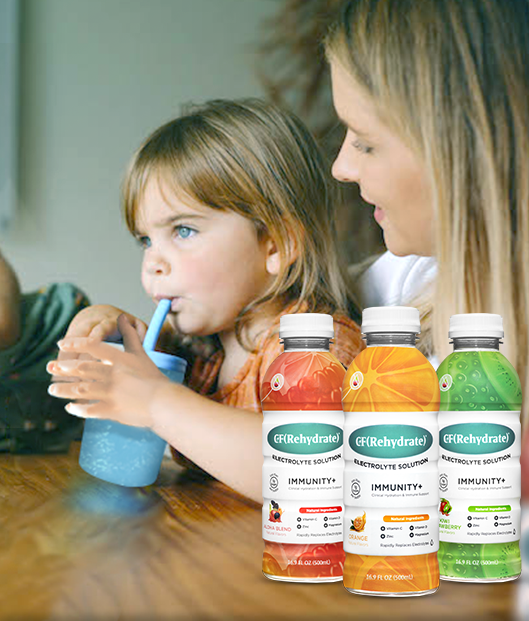The school bell has officially rung and eager-to-interact kids everywhere are returning to classrooms across the nation. But with the global pandemic persisting and children under the age of 12 unauthorized to receive COVID-19 vaccinations as of this writing—along with the start of the regular cold-and-flu season looming—the idea of keeping your family healthy, nourished, and strong in today’s climate can feel a bit overwhelming (to say the least).
Today, then, we wanted to serve up everything you need to know about our favorite, parent-friendly solution for on-the-go immune support: immunity drinks. Read on for our top tips—and get ready to tackle the back-to-school season with confidence and clarity.
What is an immunity drink?
That’s a great question! An immunity drink is a beverage that includes intentionally-selected ingredients to support a properly functioning immune system. While no immunity drink can “boost” your immune system in the way a vaccine can, thoughtfully-formulated, scientifically-backed immunity drinks do a great job of helping ensure you’re properly hydrated and nourished with essential vitamins and minerals—which, in turn, aids your immune system in operating at its best, as malnutrition is a leading cause of poor immune function.
Why should I use immunity drinks?
Immunity drinks are an effective, on-the-go solution to help your family get the vitamins and minerals they might not otherwise consume via diet on a regular basis during the busy back-to-school season. With homework back in full swing, carpools abound, lunches eaten in the cafeteria instead of under your watchful roof, and extracurricular activities adding yet another item onto parents’ already-packed to-do lists—ensuring your child eats their fruits, finishes their vegetables, and reaps the benefits of three perfectly balanced meals a day is a struggle. Add on your own career to manage, a household to run, and your personal health to stay on top of—and it can go from a “struggle” to seemingly impossible.
Immunity drinks, then, are a great supplemental solution for easing the overwhelm. They can help you ensure your child consumes the daily intake of vitamins and minerals a properly functioning immune system requires, without having to force them to shovel down steamed broccoli in the coveted few minutes they have in between the end of the school day and the start of baseball practice.
How can I use immunity drinks for immune support?
The options are endless! Throw an immunity drink in with your child’s lunch. Fill their water bottle with a clean, clinical-grade immunity beverage in place of sugary sodas and artificially-dyed sports drinks. Blend one into any smoothies or juices you might make at home. And don’t forget to give yourself the immune support you need with one as well—you can quickly consume an immunity drink while you’re shuffling little ones around, on your lunch break, or whipping up dinner.
What should I look for in an immunity drink for my family?
Not all immunity drinks were created equal. The purpose of a great immunity beverage is overall health and wellness—so it’s important to avoid excess amounts of sugar, unethically sourced ingredients, harmful additives, and anything else that can compromise your health and wellness. Be sure to look for the following things when you’re shopping for an immunity drink you can feel great about giving your family and consuming yourself:
- Less sugar: Avoid immunity beverages that contain excess amounts of added sugar. (Wondering where to start? We’ve got you covered. Our immunity drink contains only 1 gram of sugar. You read that right—only 1 gram!)
- No neon colors: Avoid immunity drinks that contain harmful colored dyes.
- Honest advertising: Read the label and check out the brand’s online presence. Are they promising things that sound too good to be true? Do their words match up with what’s on the label? Is their beverage made domestically or overseas? Do they have their own factory and, as a result, retain quality control of their product?
- The right vitamins and minerals: When it comes to immune support, you want a beverage that includes:
- Vitamin C
- Vitamin D
- Zinc
- Magnesium
- Specialty-diet friendly: Is the drink safe to consume for anyone in your household who may be gluten-free, vegan, or allergic to soy?
- Great taste: Here’s the kicker! Any parent knows: if it doesn’t taste good, the kids aren’t going for it. An immunity drink can have all of the right ingredients—but if it tastes medicinal or has an unpleasant chalky texture (which so many immunity drinks do), it will only serve to take up space in your fridge. With three fan-favorite flavors and a taste that little ones and adults alike rave about, our immunity drink was painstakingly formulated and taste-tested (over and over…and over) until our team of beverage scientists and nutritionists knew it was sure to satisfy even the pickiest of taste buds.
Is there anything else that’s important to note about immunity drinks?
There is! It’s important to note that hydration is a key component of a properly functioning immune system—so consuming an immunity drink isn’t just about the minerals and vitamins it includes; it’s also about the fluids and electrolytes you’re getting from that beverage. Water helps carry oxygen to your cells, which is a key component of proper organ functioning. When your organs are functioning at their best, so is your immune system. Staying hydrated also helps your kidneys eliminate toxins and encourages your cells to get rid of harmful waste, helping flush unwelcome visitors and cold-and-flu-causing bacteria from your body (a toxin build-up in your body weakens your immune system). The immune-supporting benefits of hydration can’t be understated. So if your little one tends to avoid water like the plague and prefers sweeter liquids instead—a clean, additive-free, but still tasty-as-ever immunity beverage might just be the thing you need to increase their fluid intake and, in turn, promote their immunity.
———
Overall, it’s no secret that the onslaught of school season—especially after an extended time period off due to the pandemic—can make maintaining your family’s health and wellness a tricky, time-consuming challenge. But with the right immunity drink on your side—you, your partner, and your little ones can easily reap the benefits of essential vitamins, minerals, and medical-grade hydration….without spending hours sweating over the stove or bargaining about broccoli. (Can we get a hallelujah?)
Bring on the clean, clinical-grade immunity drink—and let a safe, healthy fall ensue.
———
Ready for more goodness? Browse the rest of the CF Nutrition blog for empowering health, wellness, and lifestyle tips. And don’t forget to fuel yourself and your family throughout the start of school season with the clean, clinical replenishment of CF(Rehydrate)® Immunity +.



